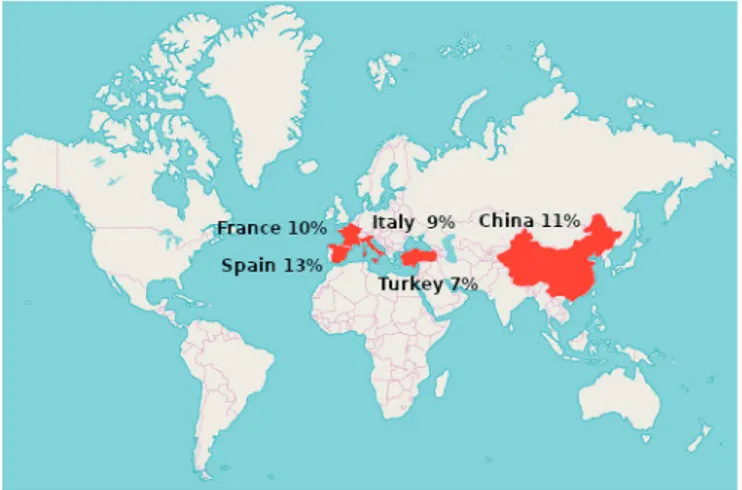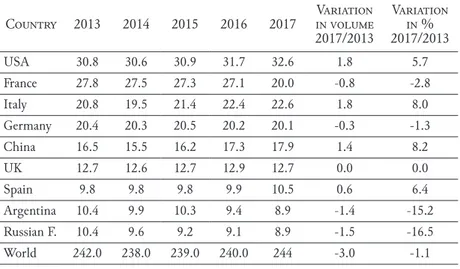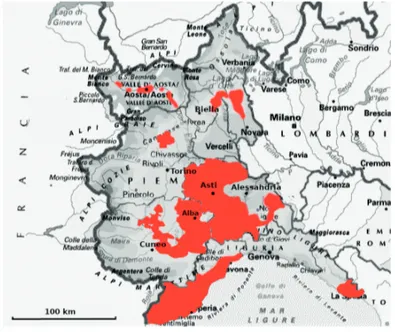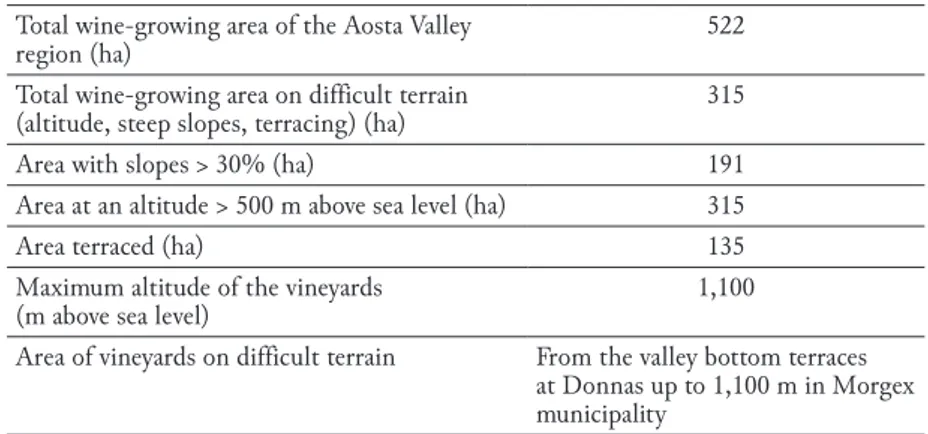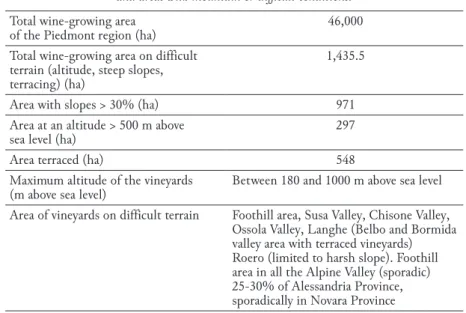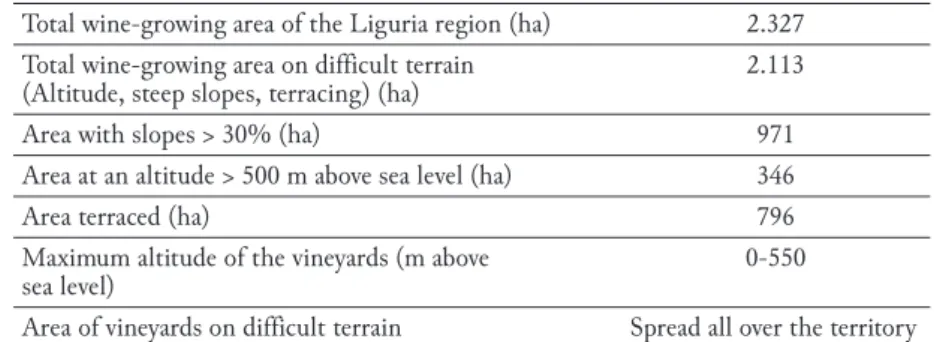Editorial
Esperienze, rappresentazioni e narrazioni geografiche 7 Dino Gavinelli
Geographical approaches
Produire des espaces sportifs décalés pour gérer un risque social: 15 l’exemple du sport LGBT
Antoine Le Blanc
Social inequalities and spatial exclusion in Italian and Canadian 37 metropolis: a challenge for citizenship
Paolo Molinari
Viticulture and Landscape in the Italian Northwestern Alpine Region 53 Gian Luigi Corinto - Anna Maria Pioletti
Le concept ‘risque’ dans les outils stratégiques d’aménagement 69 et d’urbanisme: faiblesses antérieures et evaluation des mesures
postérieures. Cas de la zone littorale de la Province de Nador au nord-est du Maroc
Hassan El Amrani - Abdellatif Tribak
2
Geographical Experiences, Representations
and Narratives
Edited by Dino Gavinelli
Roberto Zepeda - Jorge Virchez
Book reviews
R. De Miguel González, K. Donert, and K. Koutsopoulos (eds.), 105 Geospatial Technologies in Geography Education (2019)
Northwestern Alpine Region
Gian Luigi Corinto
-Anna Maria Pioletti
Università di Macerata Università della Valle d’Aosta
doi: https://dx.doi.org/10.7358/gn-2019-002-copi
Abstract
Three Northern Italian regions, Valle d’Aosta, Piedmont and Liguria, have specific identities though united by deep geographical and historical common traits. They are traditional wine-growing regions, producing several renowned wines, often in difficult areas. The ‘heroic’ viticulture, vineyard sites at altitudes over 500 meters (1,600 feet), vines planted on slopes greater than 30% on ter-races or embankments, is a cultural element of the wine-growing system in all the three regions, each having a share of mountain and slope areas. Liguria and Valle d’Aosta are much smaller regions than Piedmont; they have a big share of mountain area of the total regional surface. The paper aims describing the diversity of wine landscapes in the three regions, all of them having a large mountain and slope area within the respective total geographical surface. Data have been collected following the Grounded theory, i.e. retrieving data from very diverse sources, including direct observations. Results are that the reality of the heroic viticulture is a fundamental part of the local wine-making in Valle d’Aosta and Liguria.
Keywords: landscape; viticulture; Northwestern Alpine region; mountainous ter-ritory; terracing.
Parole chiave: paesaggio; viticoltura; regione alpina nord-occidentale; territori di montagna; terrazzamenti.
1. Introduction
1.1. Quality of wines and geography
No other crop is capable of such a biological diversity as Vitis vinifera, the vine species cultivated for winemaking; its diversity is high at very different spatial scales; grapes and wines may be different among regions separated by the Oceans as well as by the thin border between two vine-yards in the same countryside (Unwin 2005). This because the nature of soils, you may say, varies meter by meter. Moreover, diversity of final product depends on place of origin both for branded and the neighbors’ wines (Visse-Causse et Raynard 2007; Dougherty 2012; Cipolla 2013).
Over their long tradition, French wine masters produced the sound idea that wine diversity is not mere a natural fact, being mainly a cultural issue, depending on skills, capabilities, and traditions of the winemaking communities (Demossier 2011; Unwin 2012).
The Scientific and Thechnical Committee of the CERVIM (Centre for Research, Environmental Sustainability and Advancement of Moun-tain Viticulture) defined the criteria to identify the heroic viticulture: vineyard sites at altitudes over 500 meters (1,600 feet), vines planted on slopes greater than 30% on terraces or embankments.
Wine and vine are central in generating spaces, because while speak-ing of wine you are inevitably dealspeak-ing with geography; you may tell many things about different places simply mentioning different wines (Hall
et al. 2004; Cusimano 2007). In Europe, wine and vine have an
histori-cal and geographihistori-cal deep meaning, and even more in Italy where the wine landscape is a complicated melding of vineyards, wineries, country lanes, agrarian land-tenure, rural buildings, farmhouses, villages with
churches and belltowers. The rural landscape is the legacy of relent-less transformations of socioeconomic relationships, ideas, and policies, of people living in a specific place over a precise time (Gambi 1961; Lanzani 2003; Turri 2014). Thus, winegrowing determines the shape of many rural landscapes as a local/regional landmark (Corinto 2011; Demossier 2011).
Economic and cultural importance of wine-growing is proved by the
diffusion of wine production and consumption at global level. Since the end of the 1900s, the world total area of vineyards has always been more than 7 million hectares; a situation continuing over the last 15 years (Fig. 1).
France, Italy, Spain and Germany cultivate grapes mainly for wine, having a minor production of fresh grapes. Non-European countries,
like Chile, Argenti–na, South Africa, USA (California), are also impor-tant wine producers and consumers. China is still an emergent winemak-ing country notwithstandwinemak-ing its quantitative production is increaswinemak-ingly becoming important. Details of 10 top wine producers and consumers countries are in following Tables 1 and 2; Figure 2 shows that the half of the global vine area is located in only 5 countries: 13% in Spain, 11% in China, 10% in France, 9% in Italy, and 7% in Turkey.
Figure 2. – The five countries producing the half of global wine production. Source: OIV 2018.
Figure 1. – World total area of vineyards, 2000-2017. Source: OIV 2018.
Table 1. – Total wine production in the first 10 countries of the world, millions of hl, years 2014-2018.
Country 2014 2015 2016 2017 2018 in volume Variation 2018/2017 Variation in % 2018/2017 Italy 44.2 50.0 50.9 42.5 48.5 6.0 14 France 46.5 47.0 45.2 36.6 40.9 9.8 27 Spain 39.5 37.7 39.7 37.7 40.9 8.4 26 USA 23.1 21.7 23.7 23.3 23.9 0.5 2 Argentina 15.2 13.4 9.4 11.8 14.5 2,7 23 Australia 12.3 12.3 11.9 11.9 40.9 8.4 9.0 China 11.6 11.5 11.4 10.8 NA -0.1 26 Chile 9.9 12.9 10.1 9.5 12.9 3.4 36 Australia 11.9 11.9 13.1 13.7 12.5 -1.2 -9 Germany 9.2 8.8 9.0 7.5 9.8 2.3 31 World 270 273 266 248 279 31 12 Source: OIV 2018.
Table 2. – Total wine consumption in the firth 10 countries of the world, millions of hl, years 2013-2017.
Country 2013 2014 2015 2016 2017 in volume Variation 2017/2013 Variation in % 2017/2013 USA 30.8 30.6 30.9 31.7 32.6 1.8 5.7 France 27.8 27.5 27.3 27.1 20.0 -0.8 -2.8 Italy 20.8 19.5 21.4 22.4 22.6 1.8 8.0 Germany 20.4 20.3 20.5 20.2 20.1 -0.3 -1.3 China 16.5 15.5 16.2 17.3 17.9 1.4 8.2 UK 12.7 12.6 12.7 12.9 12.7 0.0 0.0 Spain 9.8 9.8 9.8 9.9 10.5 0.6 6.4 Argentina 10.4 9.9 10.3 9.4 8.9 -1.4 -15.2 Russian F. 10.4 9.6 9.2 9.1 8.9 -1.5 -16.5 World 242.0 238.0 239.0 240.0 244 -3.0 -1.1 Source: OIV 2018.
1.2. Research question, method, and data acquisition
The paper has an exploratory aims and focuses on geo-cultural
unify-ing/dividing features of vine cultivation and wine making. Questions the authors wish to answer are (i) what are the common landscape features in this area; and, conversely, which can be the ones dividing and singu-larly characterizing the three regions. Thus, the aims was not to give an exhaustive picture of the phenomenon, rather to illustrate the results of a place based case study, exposing some “vignettes […] intended to be evocative of the diversity of possible cultural geographies” (Anderson et
al. 2002, 9). For these purposes, a mix procedure has been adopted to
achieve data from literature, official statistical sources, and direct observa-tions (Glaser and Strauss 1967; Corbin and Strauss 1990). Grape-growing
in the Canavese especially shaped the landscape adding to a unique view. The vertical props of the vine, usually wooden poles, in the Aosta Valley and in the area around Ivrea are made by typical small marble pillars with a cylindrical-conical shape instead, covered by a round slab of stone.
In the Quincinetto and Carema area, the latter a zone where the wine with the same name is produced, the grid where the vine lies becomes of irregular shape to cover the scattered boulders, in order to rationally manage the space and benefit from the reflect heat from the stone. The vineyard becomes architecture and a fundamental part of a landscape, where nature and the work of man merge together in perfect harmony.
The rest of the text is organized as follows. Section 2 deals with gen-eral geo-historical features of the Italian Northwestern Alpine region.
Section 3 treats in details the wine landscapes in the Aosta Valley, Piedmont and Liguria. Section 4 is dedicated to authors’ comments on achieved results of the survey, and to conclusions.
2. The Italian Northwestern Alpine region
The EU Strategy for the Alpine region has been recently stated by the European Parliament (2016). The Italian regions, Aosta Valley, Pied-mont, and Liguria do actively participate the Alps-Mediterranean Euro
-region, including also Rhône-Alpes and Provence-Alpes-Côte d’Azur,
on the French side. It was created on July 10th, 2007, encompassing a transnational area of about 110,460 km2 and more than 17 million
tourism patterns, due to the position between the Alps and the Mediter-ranean Sea (Duran 2015).
Both the alpine and hilly zones of Valle d’Aosta and Piedmont host places rich of traditional culture and amazing landscapes. In particular, the mountainous territory of the two regions has several rock castles, roman culture finds, and a myriad of alpine lakes. Present day Liguria is a long and narrow region, ‘pressed’ to the sea by the Apennines. By a traditional way of thinking, the mountain is responsible of the very low productivity of lands and the consequent harsh and uncertain life of residents. In the past, the inner territory was impossible to be transversely crossed, and farming made difficult by the scarcity of good land, and its sloping pattern (Quaini 1979).
3. Wine landscapes in the Aosta Valley, Piedmont, and Liguria
The following Figure 3 shows the wine producing zones in Valle d’Aosta, Piedmont, and Liguria. Features are treated in the following sub-sections.
Figure 2. – Wine producing zones in Valle d’Aosta, Piedmont, and Liguria. Source: processing by the authors.
3.1. The Aosta Valley
Winemakers of the Aosta Valley have a very long tradition because they cultivated vines since many thousand years. Vines have been in the region from the 5th century B.C., even before the Romans set foot in this area as many relics testimony in the Aosta Archeological Museum. Over time, viticulture has been sometimes abandoned, due to poverty of people and barbarian invasions, especially after the Fall of Roman Empire. Middle Ages were an actual recovering period, once local vines have been replanted and winemaking returned to flourish (Frutaz 1966). Viticulture reached the peak of 3,000 vineyard hectares in the late 1800s. Afterward, due to serious diseases imported from overseas, new French and Piedmontese grapes substituted the traditional ones (Labra et al. 2002). After the peak period until today, the vineyard area decreased to about 500 total hectares. Near the 60% of this area is classified as heroic, namely run on difficult terrain or high altitude (Tab. 3).
Table 3. – Aosta Valley. Total wine-growing area, and areas with mountain or difficult conditions.
Total wine-growing area of the Aosta Valley
region (ha) 522
Total wine-growing area on difficult terrain
(altitude, steep slopes, terracing) (ha) 315 Area with slopes > 30% (ha) 191 Area at an altitude > 500 m above sea level (ha) 315
Area terraced (ha) 135
Maximum altitude of the vineyards
(m above sea level) 1,100
Area of vineyards on difficult terrain From the valley bottom terraces at Donnas up to 1,100 m in Morgex municipality
Source: CERVIM (n.d.; data updated to 2006).
Generally, the wineries are small sized. Winegrowers cultivating less than 0.2 hectare run the 35% of the whole area. A further 46% vine area is divided in plots of 0.2 to 1 hectare. Only the 2% of total vineyards is larger than 1 hectare, yet covering the 19% of the total area.
Vineyards are typically set in terraces, built up with dry stonewalls on banks. They are usually designed following the direction of the slope
for land and hydraulic system managing even though the total rainfall is usually low and needs no particular drainage attention. These vineyard rows’ direction is favorable to motorized cultivation (Labra et al. 2002; Borsotto et al. 2014).
Land use is today specialized even if, in the past, farmers used to have associated crops under the vine pergolas, such as edible vegetables or fodder. Monorail transport systems have been installed in more difficult land conditions. Rural buildings have been adapted for the household benefit or for farm tourism hospitality. Especially in recent times, farm tourism is booming (Ribière 2013).
The main grapes are both white and black ones 1. All the certified wines of the region are labeled under the only DOC Valle d’Aosta-Vallée
d’Aoste. Yet, the wine collection is very rich. The particular climatic conditions of the Valle d’Aosta, joined to the land characteristics and its exposure, location and slope, posed both difficulties and differentiating opportunities to winemakers. The unique DOC gathers 7 sub-
denomi-nations of zone and 15 vine denomidenomi-nations (Labra et al. 2002) 2. 3.2. Piedmont
Vineyards spread out both in hilly and mountainous areas of Piedmont. In both areas, winegrowing has long historical tradition characterizing landscapes, even figuring very different farming conditions and land regimes (Istat 2018). Local people have been winegrowers since Pre
-Roman and -Roman times, though the large-scale vine cultivation started
not before the 17th century. Over the second half of the 19th century, the vine disease Philloxera, imported from the Americas, spread great damages in vineyards. In many cases, the loss was total, and they have completely replanted (Eynard e Dalmasso 1990).
The central Piedmontese areas, namely Langhe, Monferrato and Roero, are today worldwide renown as high quality wine territories, 1 Prié blanc, Moscato bianco, Müller-Thurgau, Chardonnay, Pinot grigio, and Petite
Arvine are the white grapes used; Petit rouge, Nebbiolo, Pinot nero, Gamay, Fumin, Cor-nallin, Mayolet and Syrah are the black grapes used in the Aosta winemaking (Labra 2012).
2 The zone designations are Blanc de Morgex et de La Salle, Enfer d’Arvier,
Tor-rette, Nus, Chambave, Arnad-Montjovet and Donnas. The vine designations are Char-donnay, Cornalin, Fumin, Gamay, Mayolet, Merlot, Müller Thurgau, Nebbiolo, Petite Arvine, Petit Rouge, Pinot Blanc, Pinot Gris, Pinot Noir, Prëmetta and Syrah. In more recent times, Moscato bianco, Traminer aromatico, Gamaret, Erbaluce, and Vuillermin have been added as vine designations.
and such toponyms as Barbaresco and Barolo became top wine brands. Regional laws have been the basis for the actual success of Piedmontese wines, fostering a strong policy of denominations of origin, restricting the territorial producing areas and the specification of product quality.
Today, Piedmont has a vineyard area of about 46,000 ha, fostering a well defined marketing strategy base on quality designation linked to place. In fact, it has 58 PDOs, Protected designations of origin, divided in 42 DOC, Controlled designations of origin, and 42 DOCG, Controlled and guaranteed designations of origin wines. This feature puts Piedmont at the top, being the Italian region running the most numerous wine designations of origin (Arnoldi e Lisa 2014). The quality indications of wines are strictly related to product specification protocols, cultiva-tion condicultiva-tions and trellising systems, pruning technique, maximum production per hectare, and final quality of wine. Any of these technical prescriptions has a direct effect on the landscape pattern.
Local communities, not only wine growers, are entirely aware of the farming-landscape relations, and their cultural implications. In fact, they
have long invested in producing the best land regimes, namely the best fitted ones for civil residence and economic production. In reality, farming produced an exclusive and harmonious landscape, where people like to live and work (Petrini 2012; MiBACT 2016). The hilly central Piedmontese area has been declared UNESCO heritage site in 2014 (MiBACT 2014) after the procedure started on 2006 that involved residents and political institutions. That may be considered a clue of the local awareness of the cultural value of the vineyard landscape (MiBACT 2014; 2016).
In more difficult wine areas, the heroic viticulture at the foot of the mountains, vines are usually grown on embankments and terraces of diverse sizes. Landscape is traced by vineyards designed around the hills or across the hilltops, being often fragmented in small pieces of land. This fact imposes using traditional techniques, reducing the possibilities of motorization of farming. Only when the slopes are above 30%, and stone terraces and embankments are wide enough, some mechanization has been adopted. The ongoing booming of farm and wine tourism gives new life to traditional rural buildings. They have been today refurbished for private housing, holiday accommodations, usually with Bed & Breakfast formula. The only rural areas today abandoned are located in very mountainous areas where high productive and maintaining costs make winegrowing not profitable.
The mountain area is mainly used for growing red grape vines, 85%, and only 15% for white grapes.
Table 4. – Piedmont. Total wine-growing area, and areas with mountain or difficult conditions.
Total wine-growing area
of the Piedmont region (ha) 46,000 Total wine-growing area on difficult
terrain (altitude, steep slopes, terracing) (ha)
1,435.5 Area with slopes > 30% (ha) 971 Area at an altitude > 500 m above
sea level (ha) 297
Area terraced (ha) 548
Maximum altitude of the vineyards
(m above sea level) Between 180 and 1000 m above sea level Area of vineyards on difficult terrain Foothill area, Susa Valley, Chisone Valley,
Ossola Valley, Langhe (Belbo and Bormida valley area with terraced vineyards) Roero (limited to harsh slope). Foothill area in all the Alpine Valley (sporadic) 25-30% of Alessandria Province, sporadically in Novara Province
Source: CERVIM (n.d.; data updated to 2006).
3.3. Liguria
Wines of Liguria have a thousand-year-old tradition, as they were known
during the Greeks and Romans times. Afterwards, the Cinque Terre wine was reputed in the early Middle Ages as one of the finest wines. The best period should be posed from 1500 to 1800. The winemaking tradition continues today in one of the smallest Italian wine region, which has only about 1,500 ha of vineyards on a total regional area of 5,416 km2.
In such a territory, the heroic viticulture prevails, covering more than the 90% of the total area. Terraced vineyards overlooking the sea are the typical component of wine landscape. Most used forms of vine training are those of goblet pruning and vertical trellised one.
Referring to regional wine quality policies, Liguria has 8 DOC wines, 4 Typical Geographical Indication, IGT wines, and no DOCG wines (Brancucci e Ghersi 2018; Busso e Scorsone 2019) 3.
3 The main cultivated grapes are the whites, Vermentino/Pigato, Bosco, Albarola/
Bianchetta Genovese, Trebbiano toscano, Lumassina; and the reds, Sangiovese, Rossese di Dolceacqua, Dolcetto, Ciliegiolo, Merlot.
Along all the arc of Liguria from France to Tuscany, that faces the sea, and also in the inner valleys, the region shows a high density of terraced lands. For this feature, it is the second Italian region after Sicily; terraces are spread all over the region, with a certain decreasing gradient form West to East (Bonardi e Varotto 2016; Varotto et al. 2019). The big diffusion of terraced farming is due to the particular pattern of the land morphology, as some vineyards along the coast and in inland valleys are planted on hillsides, from the sea up to 550 m above sea level. Another factor is the rain regime, which concentrate erosive rains during autumn, thus necessitating a strong farming system capable of land maintaining. The terraced landscaper in Liguria shows the typical figure of the fasce, namely the strips covering the entire side of a hill.
The main part of wine-growing holdings has a total area less than
1 ha, being the 38% of the total area. Holdings between 1-3 ha comprise
39% of the area and 20% of the wineries. Wine estates with over 3 hec-tares are the 7% of the total and cover the 23% of the area. Today the vineyards are usually specialized. Some residual old ones mix vines, fruit, and olive trees.
The wine-growing areas are part of protected areas such as nine
regional parks, a national park, a national nature reserve and three regional nature reserves. As a rule the vineyards, cellars and rural build-ings, the largest of which are often turned into private houses or holiday farms, are a long way from built up areas.
Table 5. – Liguria. Total wine-growing area, and areas with mountain or difficult conditions.
Total wine-growing area of the Liguria region (ha) 2.327 Total wine-growing area on difficult terrain
(Altitude, steep slopes, terracing) (ha) 2.113 Area with slopes > 30% (ha) 971 Area at an altitude > 500 m above sea level (ha) 346
Area terraced (ha) 796
Maximum altitude of the vineyards (m above
sea level) 0-550
Area of vineyards on difficult terrain Spread all over the territory
4. Comments and concluding remarks
The paper aimed at describing the geo-cultural unifying/dividing
features of vine cultivation and wine making in Northwestern Italian regions of Valle d’Aosta, Piedmont, and Liguria. They pertain to the Northwestern Italian Alpine region and are the Italian components of the envisaged Alps-Mediterranean Euroregion. They share the
cultiva-tion of vine in ‘heroic’ condicultiva-tions, yet in very different situacultiva-tions. Valle d’Aosta is a totally mountain region, and its viticulture is pretty ‘heroic’; Piedmont has large winegrowing areas in hilly conditions, and its ‘heroic’ viticulture is residual; Liguria is a long and narrow geographical area, ‘pressed’ to the sea by the Apennines, and its viticulture lays mainly on difficult slope hilly areas. In these regions, vine is a plant very capable of flourishing in very diverse soil and climate environments. It generates a wide range of humans/nature relationships, giving sense to many expres-sion of local culture, visible as variable landscape features. It is capable of giving high revenues and profits to winemakers acting in the most favorable conditions, and even yet sustain less favorable areas.
In all the three regions, winegrowing has a long lasting tradition, involving local communities in producing wine, and specific landscape settings; this experience contributed to the consolidation of rural cultural traditions, social rites, daily behaviors, knowledge and skills shared among residents. The rural and farming society is increasingly aware of its own capability in managing the material landscape as a cultural heritage. This is proved by initiatives related to quality denominations of wines, the specific promotion of the so called ‘heroic viticulture’, and the inscrip-tion of wine landscapes in the UNESCO Heritage list by Piedmont. It is apparent that the local communities take care of their wine landscapes because they are aware of their importance both for economic, social, and environmental reasons. This increasing social awareness is surely a unify-ing feature for the Northwestern Italian Alpine region, inducunify-ing also the positive idea that wine landscapes are a fundamental scenery for tourism.
Nevertheless, the winegrowing of Piedmont shows big differences from that of the other two regions, enlightening a strong territorial divide. First of all, the main part of Piedmontese vineyards is located in the hilly area of the region. Here, the wine landscape is a pretty elegant mosaic of diverse human settlements and of smart use of land. Since more than a hundred years, wine-growing is an actually market-oriented
activity, based on a long run vision aiming to maintain a not-
Piedmon-tese winegrowers are not ‘relegated’ in difficult areas, as the other two regions’ wine producers mainly do.
Wine landscapes of Valle d’Aosta, and Liguria are unavoidably based on labor intensive techniques, necessary to build terraces, and cultivate sloping areas. Their visual quality is high, for their ‘architectural’ look-ing, which involves high costs of managing and maintenance. In these less economic favorable areas, wine-growing is capable of characterizing
the landscape with peculiar tree-training forms and, moreover, specific
land-tenure systems, which often become a landmark, a cultural
distinc-tion, capable of inducing tourism attraction.
Today, the ‘heroic’ viticulture play a different role in Valle d’Aosta, and Liguria, in comparison to Piedmont, where it is a marginal activity. In the future, it could be a benchmark to be imitated also by a larger part of Piedmont winegrowers, due to the changing of consumers’ pref-erences, and even more for the climate change. An increasing part of consumers show preferences more oriented to high quality and less alco-holic white wines, which are best produced in fresh climate. Even more, the climate change can push the limit of cultivation of wine to higher altitudes, pressing vineyards to ‘climb’ the mountains in order to main-tain favorable farming conditions. The landscape, a visible manifestation of human action on the land, becomes therefore a cultural inheritance with a twofold value: that of a resource for development and that of a patrimony to pass on. The landscapes become a prominent factor in wine promotion and in that of their image. The image an anthropic landscape of the wine production area is the wine’s ticket for promotional success.
Due to the exploratory aim of the research, results must be considered partial and to be deepened in future. Nevertheless, the findings encour-age the authors to continue the investigation on the relation between wine-growing and landscape, within the approach of cultural geography,
fostering comparisons with other regions located in the Italian Alps.
References
Anderson, K., M. Domosh, S. Pile, and N. Thrift, eds. 2002. Handbook of Cultural
Geography. London: Sage.
Arnoldi, S., e G. Lisa, a cura di. 2014. Torino DOC. Selezione enologica della
Came-ra di commercio di Torino. Torino: CameCame-ra di commercio industria
Bonardi, L., e M. Varotto. 2016. Paesaggi terrazzati d’Italia. Eredità storiche e nuove
prospettive. Milano: FrancoAngeli.
Borsotto, P., S. Chaussod, S., e A. Trione, a cura di. 2014. Vitivinicoltura,
frutti-coltura e allevamento ovi-caprino in Valle d’Aosta. I risultati tecnico-economici
delle aziende del ‘campione satellite’ RICA 2010-2012. Roma: Inea.
Brancucci, G., e A. Ghersi. 2018. Geodiversità dei vigneti liguri. Le relazioni tra
pae-saggio, suolo, vitigni e vino. Firenze: Edifir.
Busso, M., e A. Scorsone. 2019. Vinibuoni d’Italia 2019. Milano: Touring.
CERVIM n.d. Zone viticole di montagna, terrazzate e in forte pendenza associate al
CERVIM. [14/01/2018]. http://www.cervim.org/zone-viticoltura-montagna.
aspx.
Cipolla, C. 2013. Il Maestro di vino. Milano: FrancoAngeli.
Corbin, J., and A. Strauss. 1990. “Grounded Theory Research: Procedures, Canons, and Evaluative Criteria”. Qualitative Sociology 13 (1): 3-21.
Corinto, G.L. 2011. “Wine Terroir Concept: Some Preceding in Arrigo Serpieri’s Agrarian Zone”. Enometrica 4 (1): 43-56.
Cusimano, G. 2007. “Vino e vocazione”. Treballs de la Societat Catalana de Geografia 60: 71-82.
Demossier, M. 2011. “Beyond Terroir: Territorial Construction, Hegemonic Dis-courses, and French Wine Culture”. Journal of the Royal Anthropological
Institute 17 (4): 685-705.
Dougherty, P.H., ed. 2012. The Geography of Wine: Regions, Terroir and Techniques. Dordrecht: Springer.
Duran, M. 2015. Mediterranean Paradiplomacies: The Dynamics of Diplomatic
Reter-ritorialization. Leiden (NL): Hotei Publishing.
European Parliament. 2016. European Parliament Resolution of 13 September 2016 on
an EU Strategy for the Alpine Region. [26/02/2019]. http://www.europarl.
europa.eu/sides/getDoc.do?pubRef=-//EP//TEXT+TA+P8-TA-2016-0336+0+DOC+XML+V0//EN.
Eynard, I., e G. Dalmasso. 1990. Viticoltura moderna. Manuale pratico: evoluzione
della viticoltura, nozioni generali, tecnica viticola, ampelopatie e difesa del vi-gneto. Milano: Hoepli.
Frutaz, A.P. 1966. Le fonti per la storia della Valle d’Aosta, vol. I. Roma: Edizioni di Storia e Letteratura.
Gambari, F.M. 1994. “Le origini della viticoltura in Piemonte. La protostoria”. In
Vigne e vini nel Piemonte antico, a cura di R. Comba, 17-41. Alba (CN):
Famija Albeisa - Società per gli studi storici della provincia di Cuneo -
L’Ar-ciere.
Gambi, L. 1961. Critica ai concetti geografici di paesaggio umano. Faenza: Fratelli Lega. Glaser, B.G., and A.L. Strauss. 1967. The Discovery of Grounded Theory: Strategies
Hall, C.M., L. Sharples, R. Mitchell, N. Macionis, and B. Cambourne, eds. 2004.
Food Tourism around the World. London - New York: Routledge.
Istat 2018. Superficie (ettari) e produzione (quintali): uva da tavola, uva da vino,
vi-no. Dettaglio per regione, Anno 2017. [24/02/2019]. http://agri.istat.it/jsp/
dawinci.jsp?q=plC260000010000022100&an=2017&ig=1&ct=604&id=15A %7C18A%7C21A%7C73A.
Labra, M., G. Moriondo, A. Schneider, F. Grassi, O. Failla, A. Scienza, and F. Sala. 2002. “Biodiversity of Grapevines (Vitis vinifera L.) Grown in Aosta Valley”.
Vitis 41 (2): 89-92.
Lanzani, A. 2003. I paesaggi italiani. Sesto San Giovanni (MI): Meltemi.
MiBACT 2014. I paesaggi vitivinicoli del Piemonte: Langhe-Roero e
Monferra-to nella lista del patrimonio mondiale UNESCO. Franceschini: “È il 50° si-to UNESCO italiano, particolarmente orgoglioso del risultasi-to”. Comunicasi-to
stampa, 22 giugno.
MiBACT 2016. Valorizzare un Patrimonio UNESCO. Il primo progetto finanziato
con la Legge 77/2006 nei paesaggi vitivinicoli del Piemonte. Bra - Alba (CN):
Associazione per il Patrimonio dei Paesaggi Vitivinicoli di Langhe-Roero e
Monferrato.
OIV 2018. Distribution of the World’s Grapevine Varieties. Paris: OIV. Petrini, C. 2012. Slow food. Le ragioni del gusto. Roma - Bari: Laterza.
Quaini, M. 1979. Per la storia del paesaggio agrario in Liguria. Savona: Camera di Commercio, industria, artigianato e agricoltura.
Ribière, G. 2013. Sustainable Tourism in the Alps: Report on the State of the Alps. Innsbruck - Bolzano/Bozen: Permanent Secretariat of the Alpine
Conven-tion.
Turri, E. 2014. Semiologia del paesaggio italiano. Venezia: Marsilio.
Unwin, T. 2005. Wine and the Vine: An Historical Geography of Viticulture and the
Wine Trade. London - New York: Routledge.
Unwin, T. 2012. “Terroir: At the Heart of Geography”. In The Geography of Wine, edited by P.H. Dougherty, 37-48. Dordrecht: Springer.
Varotto, M., L. Bonardi, and P. Tarollo, eds. 2019. World Terraced Landscapes:
History, Environment, Quality of Life. Cham (CH): Springer International
Publishing.
Visse-Causse, S., et J. Raynard. 2007. L’appellation d’origine. Valorisation du terroir.
